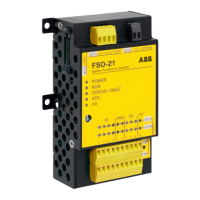Safety functions 193
Priorities between safety functions
When several safety functions are active at the same time, these priorities apply:
1. the STO function overrides the SSE and SS1 functions
2. the SSE function overrides the SS1 function.
The overriding function will also override the indications of the low priority functions,
eg, by switching off the outputs of the safety functions with lower priority.
The POUS function is independent of other safety functions. If you activate the POUS
function when another safety function is active (for example, during a deceleration
ramp), it can disturb the performance of the other safety function. ABB recommends
that you do not activate the POUS function when the motor is running.
Example: The SS1 function uses SAR1 parameters to define the stop ramp. In some
situations (for example, with PROFIsafe-related faults or trip limit hits), the FSO
module activates the Safe stop emergency (SSE) function. When the SSE function
has been configured as “Emergency ramp”, it uses SAR0 parameters to define the
stop ramp. If the FSO module activates the SSE function while the SS1 function is
active, the SSE function overrides the SS1 function. Therefore, SAR0 parameters are
used instead of SAR1 parameters to define the stop ramp.
When a safety function overrides another safety function, this does not remove the
request of the overridden safety function. Therefore, the overridden safety function
restarts after the other safety function has been completed and acknowledged.
Dependencies between safety functions
The figure below shows how different safety functions of the FSO module are related
to each other and the drive STO function.
1. Zero speed limit reached: The SS1 and SSE (with emergency ramp) functions
activate the drive STO function (that is, open the drive STO circuit) when the
motor speed reaches the user-defined zero speed limit.
2. Trip limit hit: The SMS and SLS functions activate the SSE function when the
motor speed reaches a user-defined trip limit. The SDI function activates the SSE
function when motor rotation reaches the user-defined SDI tolerance limit.
3. Monitoring limit hit: The SS1, SSE (with emergency ramp), SLS and SDI functions
(with ramp monitoring) activate the STO function of the FSO module when the
motor speed reaches a monitoring limit.
The STO, SSE with immediate STO and POUS functions activate the drive STO
function, that is, open the drive STO circuit.
The POUS function activates the drive STO independently of the stopping functions
of the FSO module.

